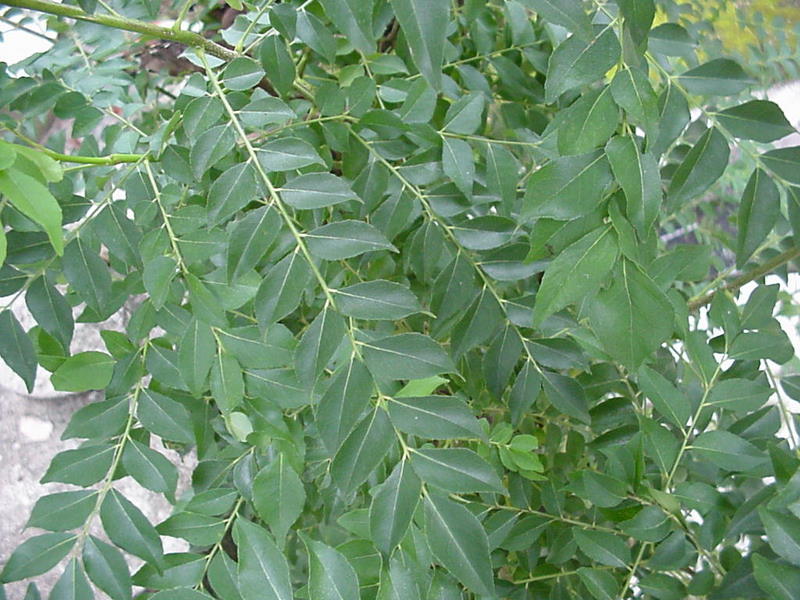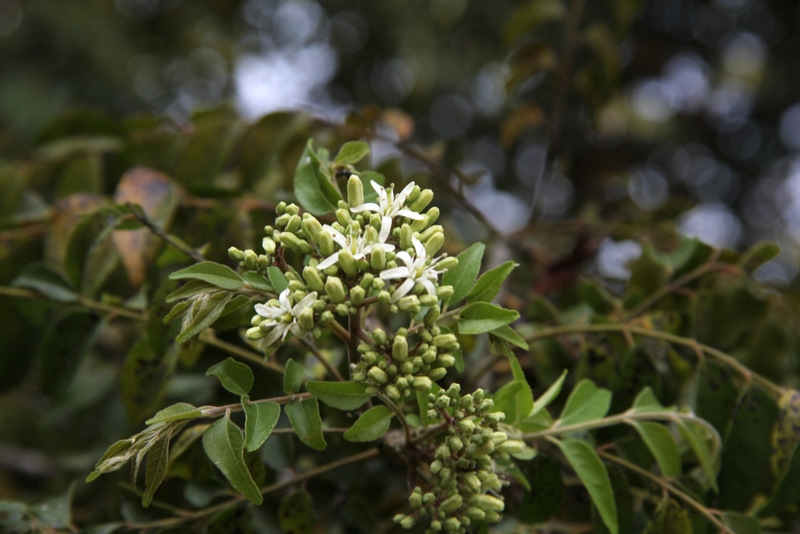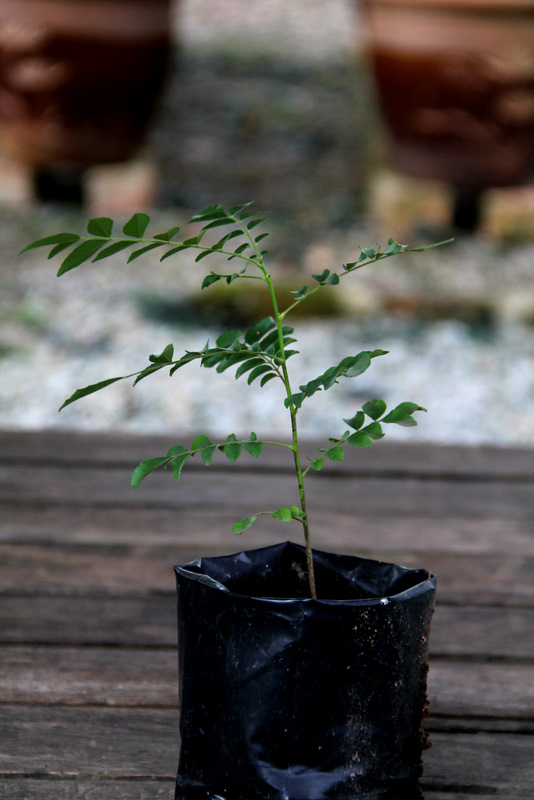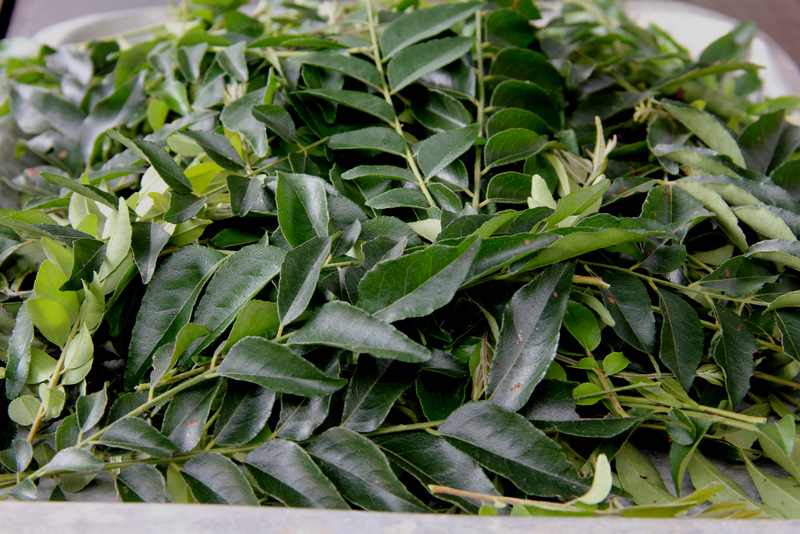Botanical Names
Murraya koenigii
Common Names
| Malaysia | Daun kari |
| English | Curry leaves |
| Indonesia | Salam koja, daunkari, temurui |
| India | Kadipatta, kadinimb, harri |
Family
Rutaceae
Introduction
The plant is believed to be native to India and Sri Lanka and subsequently introduced to other South East Asian countries. It is now widely planted through out the tropics. It is normally planted as an ornamental plant. The plant is quite hardy even though the plants prefer well-drained soil with high organic matter contents. In Malaysia, the leaves are highly valued in Indian cooking such as in the preparation of curries, chutney and murukku.[1]



Morphological Features
It is a small evergreen tree, growing 4-6 m tall, with a trunk up to 40 cm diametre. The leaves are pinnate, with 11-21 leaflets, each leaflet 2-4 cm long, 1-2 cm broad and serrated. They are highly aromatic. The flowers are small white, and fragrant. The small black, shiny berries are edible, but their seeds are poisonous.[1]
Medicinal Properties and Usage
The leaves are also normally used as a herb in Ayurvedic medicine. It has antidiabetic, antioxidant, antimicrobial, anti-inflammatory and hepatoprotective properties. Curry leaves are also known to be good for keeping hairhealthy and long. It is also being used to treat indigestion, constipation and poisonous insect bites, inflammations and swellings.[1][2][3][4][5]
Soil Suitability and Climatic Requirement
‘Kari’ plant is quite hardy and well adapted on most soil types. However, it is best suited to well-drained soils, with high organic matter content and high water table (more than 60 cm). The plant needs about 2,000 to 3,000 mm of rainfall, full sunlight and temperature of 25-38°C for optimum growth.[1]
Field Preparation
Land Preparation
Prior to planting, normal field operations such as land clearing, disc ploughing and rotovation are to be conducted. GML (Ground Magnesium Limestone) at the rate of 100 g per planting hole are applied as to improve the soil pH. The size of a planting hole is 30 cm x 30 cm x 30 cm.[1]
Production of Planting Materials
Seeds are normally used to propagate ‘kari’ plant. The vegetative propagation techniques by using stem cuttings or the plantlets obtained from the lateral roots can also be adopted. If the seeds are to be used, it should be obtained from the fully matured fruits. The seeds must be sowed fresh since it cannot be stored. The seeds from the dried fruits are not viable. The seeds start to germinate at 3-4 weeks after sowing. These seedlings are then transferred to the polybags at about 2 weeks after germination. They are then kept under about 50% shade in the nursery and ready for field plating when it grows to about 60 – 80 cm high.[1]

Field Planting
The recommended planting distance is 1m between plants and 3m between rows giving a population density of about 3,330 plants/ha. The plant should be managed to about 2 m in canopy width. To avoid the transplanting shock, field planting should be done at the beginning of the rainy season. Supplemented irrigation is required if transplanting is done during the dry season.[2]
Field Maintenance
Fertilisation
Both the compound fertiliser NPK (15:15:15) and processed chicken is recommended for maximum growth. Chicken manure is applied in the first year only at the rate of 1.0 kg/planting hole during planting and another 0.5 kg at 6 months after planting. The compound fertiliser is applied at the rate of 500, 750 and 1,000 g/plant in the 1st, 2nd and 3rd year upward, respectively. The recommended amount is divided into two equal portion sand applied at six months intervals.[1]
Weed Control
For the first five months after planting, weedsare controlled by two rounds of rotor-tillage operations. The contact herbicides can be used for the one-year-old crops and older.[1]
Water Management
Supplementary irrigation is required for optimum crop growth and yield. Drip irrigation system is recommended for this crop.[1]
Pest and Disease Control
Currently, there are no serious pest and disease problems in the field planting of ‘kari’ plant.[1]
Harvesting
The first harvest can be conducted as early as 12 months after field planting. The leaves are harvested by cutting at the base of the petiole. The recommended harvesting intervals are every 2 months. The potential yield depends on the crop vigour. The potential fresh yield of a mature crop is 22 t/ha/year.[1]

Postharvest Handling
The leaves are consumed fresh. In their fresh form, they have a short shelf life though they may be stored in a freezer for quite some time. The leaves can also be kept as dried product although the aroma is much inferior.
Estimated Cost Of Production
The estimated cost of production for the established crop (year 3 and above) is RM12,000. Based on the fresh yield of about 22.0 t/ha from the fully established crop, the production cost of fresh leaf is about RM0.55/kg. The production cost was estimated based on the cost of current inputs during writing of this article.[1]
Read More
References
- Anon 2010. Kertas maklumat penanaman daun kari. Kuala Lumpur : Department of Agriculture Peninsular Malaysia (unpublished)
- Anon 2002. Compendium of Medicinal Plants Used in Malaysia. Kuala Lumpur : HMRC-IMR
- Musa, Y. Azimah, K. and Zaharah, H. 2009. Tumbuhan Ubatan Popular Malaysia. Serdang : MARDI
- Kamarudin Mat-Salleh and Latiff, A. (editor). 2002. Tumbuhan Ubatan Malaysia. Bangi : UKM
- Wiart, C. 2002. Medicinal Plants of South East Asia. Pg 270, Kuala Lumpur : Pearson Malaysia Sdn Bhd


